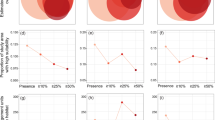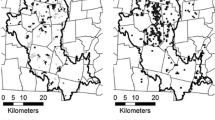Abstract
The distribution of invasive plants across a landscape is largely governed by disturbance invoking anthropogenic land-use practices and propagule pressure. However, spatial variability associated with anthropogenic disturbances and propagule pressure is seldom used to develop distribution models of invasive plants. This study makes use of large-scale survey data to develop a spatially explicit predictive model for the invasive wetland plant—purple loosestrife. Using loosestrife presence data and land use land cover information, we first predicted loosestrife occurrences in two types of wetland habitat, namely herbaceous wetlands and open-water edges, with a series of logistic regression models that incorporated surrounding land-use at three different neighborhood scales. The best-fitting surrounding land-use model was then combined with three different distance constraint models that simulated propagule pressure. Loosestrife occurrence as a function of surrounding land-use showed best fit at a neighborhood radius of 400 m. Predictions made from the surrounding land-use model at the 400 m scale were fairly accurate and loosestrife invasion of wetland locations were correlated with the proportion of anthropogenic land-use conditions. Inclusion of an autocovariate simulating propagule pressure improved model fit and performance significantly. Model findings suggest that spatially explicit incorporation of surrounding land-use yields an ecologically realistic projection of invasion risk wherein disturbance prone habitat edges tend to be more invasible. Combining this prediction with location specific estimates of propagule pressure further reduces uncertainty by spatially constraining areas of high invasion risk. Our approach is applicable to other invasive plants since it is based on two key drivers of plant invasion: disturbance and propagule-pressure.





Similar content being viewed by others
References
Allouche O, Steinitz O, Rotem D et al (2008) Incorporating distance constraint into species distribution models. J Appl Ecol 45:599–609
Augustin NH, Mugglestone MA, Buckland S (1996) An autologistic model for spatial distribution of wildlife. J Appl Ecol 33:339–347
Betts MG, Ganio LM, Huso MMP et al (2009) Comment on “Methods to account for spatial autocorrelation in the analysis of species distributional data: a review”. Ecography 32:374–378
Blossey BL, Skinner LC, Taylor J (2001) Impact and management of purple loosestrife (Lythrum salicaria) in North America. Biodivers Conserv 10:1787–1807
Cadenasso ML, Pickett STA (2001) Effect of edge structure on the flux of species into forest interiors. Conserv Biol 15:91–97
Chytrý M, Jarošik V, Pyšek P et al (2008) Seperating habitat invasibility by alien plants from actual level of invasion. Ecology 89:1541–1553
Dormann CF (2007) Assessing the validity of autologistic regression. Ecol Modell 207:234–242
Elith J, Leathwick JR (2009) Species distribution models: ecological explanation and prediction across space and time. Annu Rev Ecol Evol Syst 40:677–697
Elith J, Graham CH, Anderson RP et al (2006) Novel methods improve predictions of species distribution from occurrence data. Ecography 29:129–151
Engler R, Guisan A, Rechsteiner L (2004) An improved approach for predicting the distribution of rare and endangered species from occurrence and pseudo-absence data. J Appl Ecol 41:263–274
Eschtruth AK, Battles JJ (2011) The importance of quantifying propagule pressure to understand invasion: an examination of riparian forest invasibility. Ecology 92:1314–1322
Fielding AH, Bell JF (1997) A review of methods for the assessment of prediction errors in conservation presence/absence models. Environ Conserv 24:38–49
Guisan A, Thuiller W (2005) Predicting species distribution: offering more than simple habitat models. Ecol Lett 8:993–1009
Hampe A (2004) Bioclimate envelope models: what they detect and what they hide. Glob Ecol Biogeogr 13:469–471
Hawkins BA, Bini LM, DeMarco P et al (2007) Red herrings revisited: spatial autocorrelation and parameter estimation in geographical ecology. Ecography 30:375–384
Hobbs RJ (2000) Land-use changes and invasions. In: Mooney HA, Hobbs RJ (eds) Invasive species in a changing world. Island Press, pp 65–93
Hobbs RJ, Humphries SE (1995) An integrated approach to the ecology and management of invasive species. Conserv Biol 9:761–770
Hulme PA (2012) Weed risk assessment: a way forward or waste of time. J Appl Ecol 49:10–19
Jiminez-Velvarde A, Peterson AT, Soberon J et al (2011) Use of niche models in invasive species risk assessment. Biol Invasions 13:2785–2797
Kriticos DJ, Sutherst RW, Brown JR et al (2003) Climate change and potential distribution of an invasive alien plant: Acacia nilotica sp. indica in Australia. J Appl Ecol 40:111–124
Latimer AM, Wu S, Gelfand AE, Silander JA Jr (2006) Building statistical models to analyze species distributions. Ecol Appl 16:33–50
Lavoie C (2008) Should we care about loosestrife? The history of an invasive plant in North America. Biol Invasions 12:1967–1999
Lockwood J, Cassey P, Blackburn TM (2009) The more you introduce the more you get: the role of colonization pressure and propagule pressure in invasion ecology. Divers Distrib 15:904–910
MacNally R (2000) Regression and model-building in conservation biology, biogeography and ecology: the distinction between—and reconciliation of—‘predictive’ and ‘explanatory’ models. Biodivers Conserv 9:655–671
Maheu-Giroux M, de Bois S (2007) Landscape ecology of Phragmites australis invasion in a network of linear wetlands. Landsc Ecol 22:285–301
Milbau A, Stout JC, Ganae JB et al (2009) A hierarchical framework for integrating invasibility experiments incorporating different factors and scales. Biol Invasions 11:941–950
Miller J, Franklin J, Aspinal R (2007) Incorporating spatial dependence in predictive vegetation models. Ecol Modell 202:225–242
Pauchard A, Alback PB (2006) Edge type defines alien plant invasion along Pinus contorta burned, highway and clear-cut forest edges. For Ecol Manage 223:327–335
Pearson RG, Dawson TP (2003) Predicting the impacts of climate change on species distribution: are bioclimate models useful? Glob Ecol Biogeogr 12:361–371
Pimentel D, Zuniga R, Morrison D (2005) Update on the environmental and economic costs associated with alien-invasive species in the United States. Ecol Econ 52:273–288
Rachich JR, Reader RJ (1999) An experimental study of wetland invasibility by purple loosestrife (Lythrum salicaria). Can J Bot 77:1499–1503
Rouget M, Richardson DM (2003) Inferring process from pattern in plant invasions: a semi-mechanistic model incorporating propagule pressure and environmental factors. Am Nat 162:713–724
Speigelhalter D, Thomas A, Best N et al (2003) WinBUGS user manual. MRC Biostatistics unit, Cambridge, UK
Sullivan MJP, Davies RG, Reino L, Franco AMA (2012) Using dispersal information to model species–environment relationship of spreading non-native species. Methods Ecol Evol 3:870–879
Thomas SM, Moloney KA (2013) Hierarchical factors impacting the distribution of an invasive species: landscape context and propagule pressure. Landsc Ecol 28:81–93
Thompson DQ, Stuckey R, Thompson EB (1987) Spread, impact and control of purple loosestrife (Lythrum salicaria) in North American wetlands. Fish Wildl Rep 2:1–55
Václavík T, Meentemeyer RK (2009) Invasive species distribution model (iSDM): are absence data and dispersal constraints needed to predict actual distributions? Ecol Modell 220:3248–3258
Václavík T, Kupfer JA, Meentemeyer RK (2012) Accounting for multi-scale autocorrelation improves performance of species distribution models (iSDM). J Biogeogr 39:42–55
VanDerWal J, Shoo LP, Graham C, Williams SE (2009) Selecting pseudo-absence data for presence-only distribution modeling: how far should you stray from what you know? Ecol Modell 220:589–594
Vilà M, Ibáňez I (2011) Plant invasions in the landscape. Landsc Ecol 26:461–472
Vilà M, Corbin JD, Dukes JS, Pino J, Smith SD (2006) Linking plant invasions to environmental change. In: Canadell J, Pataki D, Pitelka L (eds) Terrestrial ecosystems in a changing world. Springer, Berlin, pp 115–124
Williams NSG, Hahs AK, Morgan JW (2008) A dispersal-constrained habitat suitability model for prediction of alpine vegetation. Ecol Appl 18:347–359
Wu H, Huffer RW (2001) Modelling the distribution of plant species using autologistic regression model. Environ Ecol Stat 4:31–48
Acknowledgments
We are thankful to Minnesota-DNR’s Invasive Species Program for the loosestrife data and for financially supporting the first author in the form of a summer stipend. The first author is grateful to Luke Skinner and Adam Doll of Minnesota-DNR for providing valuable on-field information regarding loosestrife invasion and spread. We are also thankful to members of plant lab group at Iowa State University and two anonymous reviewers for suggesting ways to improve the model presentation and write-up. The first author is also grateful to the EEB program at Iowa State, which provided research support through several semesters of support as a Research Assistant.
Author information
Authors and Affiliations
Corresponding author
Appendices
Appendix 1
See Fig. 6.
Comparison of the fitted decline in propagule pressure estimates between nearest neighbor model (NN) and nearest negative exponential decay model (NED) as a function of increasing distance for herbaceous wetlands. For the NED model, the decline in propagule pressure was estimated by finding the best-fitting rate of decay parameter (i.e. b = 0.0019). See ‘Methods’ for details on model structure and parameter estimation (Note: for open water edges the difference in propagule pressure patterns is overall similar)
Appendix 2
See Table 3.
Appendix 3
See Fig. 7.
Map of the four conterminous counties selected as the study area showing loosestrife invasion risk for both herbaceous wetlands and open water edges as predicted by the autologistic regression model with propagule pressure estimated using the cumulative distance (CD) model. The empty white space represents the matrix around the wetland habitats, which comprise of the remaining 12 land use land cover categories
Rights and permissions
About this article
Cite this article
Thomas, S.M., Moloney, K.A. Combining the effects of surrounding land-use and propagule pressure to predict the distribution of an invasive plant. Biol Invasions 17, 477–495 (2015). https://doi.org/10.1007/s10530-014-0745-7
Received:
Accepted:
Published:
Issue Date:
DOI: https://doi.org/10.1007/s10530-014-0745-7






